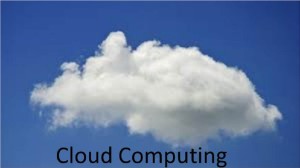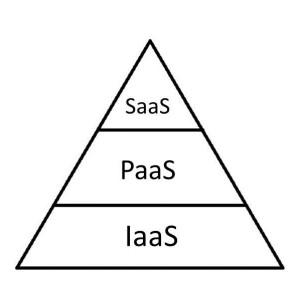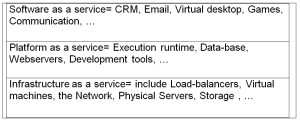Cloud Computing
 In computer networking, cloud computing is basically large number of server machines connected through a communication network like the Internet. It is basically the usage of resources spread upon a network, and means the ability to run a program or application on many connected computers at the same time. Cloud is just a comparison to Internet. Go back to the days of flowcharts and presentations that represent the enormous server-farm structure of the Internet a puffy, white cumulonimbus cloud, accommodating connections and giving out in portions. We can compare Cloud computing to grid computing in which not used process sequences of all computer in the network are controlled and made use to resolve glitches which are severe for any single machine. In cloud computing, small scale businesses can access these resources and increase or decrease resources as and when required. The pay-as-you-use system is engineered to let new businesses efficiently manage and only pay for what they use.
In computer networking, cloud computing is basically large number of server machines connected through a communication network like the Internet. It is basically the usage of resources spread upon a network, and means the ability to run a program or application on many connected computers at the same time. Cloud is just a comparison to Internet. Go back to the days of flowcharts and presentations that represent the enormous server-farm structure of the Internet a puffy, white cumulonimbus cloud, accommodating connections and giving out in portions. We can compare Cloud computing to grid computing in which not used process sequences of all computer in the network are controlled and made use to resolve glitches which are severe for any single machine. In cloud computing, small scale businesses can access these resources and increase or decrease resources as and when required. The pay-as-you-use system is engineered to let new businesses efficiently manage and only pay for what they use.
The aim of cloud computing is to use high performing computing or supercomputer. Cloud computing allows for efficient computing by integrating the storage of data, processing and the bandwidth. Most of the people who use internet have availed the services which use cloud computing the examples are Hotmail, Yahoo or Gmail etc. One just needs to have a computer or internet enabled device and an internet connection, thus one can start to send emails. The email management software and the server are all on the cloud network and are managed by the service provider. This somewhat comparable to the anecdote as there was want for milk, to fulfil the want the cow was purchased. Since we only want to use emails services hence it does not seem logical to invest in software and hardware for sending emails.

There are certain Service models that are exhibited by cloud computing.
(IaaS) = infrastructure as a service.
(PaaS)= platform as a service.
(SaaS)= software as a service.

Deployment Models & Concepts of Cloud Computing include
Community Cloud: several organizations with common concerns from a specific community and shares the infrastructure. This can be managed and hosted by third party or internally by the organization. As compared to public cloud the costs are distributed over fewer users but still it is more economical as compared to that of a private cloud.
Public Cloud: organizations having similar requirements and are looking to share infrastructure. Computing resources are made available online for the public by service providers. This allows user to access resources on cloud like stored data, Applications or Software. It is more economical as compared to Community Cloud and private cloud. There are many benefits the storage and the computing services are very efficient. Information sharing and connectivity to the server are easily established. It is extremely reliable and redundant etc.
Private cloud: A single organization for which the cloud infrastructure is operated solely. The cloud-based resources are distributed to unique platform, providing security, high performance, and user experience. Just like sitting in front of the local PC you can access the desktop, modification settings, run applications or access data. The private cloud model is far less economical as compared to public cloud and community cloud.
Considering safety regarding cloud computing it seems to be vulnerable as it is based on a mechanical platform even though it seems to be virtually based. The safety of the data is also dependent on the determination and will of the individual who want it. Disaster Recovery solution is available in Cloud Computing. An epitome shift will occur as we turn to cloud computing and it will touch many different sub- category companies in computer industry.



